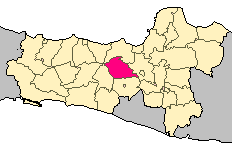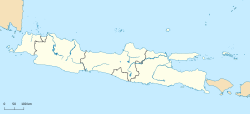Top Qs
Timeline
Chat
Perspective
Temanggung Regency
Regency in Central Java, Indonesia From Wikipedia, the free encyclopedia
Remove ads
Temanggung Regency (Indonesian: Kabupaten Temanggung) is an inland regency in the Central Java Province of Indonesia. It covers a land area of 870.65 km2 and had a population of 708,546 at the 2010 Census[2] and 790,174 at the 2020 Census;[3] the official estimate as of mid-2024 was 814,879, comprising 409,118 males and 405,761 females; it was projected to rise to 821,118 at mid 2025.[1] Its capital is the town of Temanggung.
All travellers going to the Dieng temple complex from Yogya or Semarang have to pass through this regency.
Temanggung Regency is famous for longan, a small sweet fruit that is harvested in January and February.
Remove ads
Geography
Summarize
Perspective
Temanggung Regency is located on the volcanic Dieng Plateau with an average elevation between 500 and 1450 metres, although the more northern districts (kecamatan listed at the bottom end of the table below) lie off the plateau in the plains to the north. It is landlocked. The volcanoes Mount Sundoro and Mount Sumbing rise on its border with the Wonosobo Regency. Its major drainage system is the Progo River and its tributaries.
Borders
It is bordered by:
- Kendal Regency to the north
- Semarang Regency to the east
- Magelang Regency to the south
- Wonosobo Regency to the southwest
Administrative districts
Temanggung Regency is divided into the following twenty districts (kecamatan), listed below with their areas and their populations at the 2010 Census[2] and the 2020 Census,[3] together with the official estimates projected as at mid-2025.[1] The table also includes the number of administrative villages in each district (totaling 266 rural desa and 23 urban kelurahan), and their postcodes.
Notes: (a) including two kelurahan - Parakan Wetan and Parakan Kauman. (b) comprising nineteen kelurahan (Banyuurip, Butuh, Giyanti, Jampirejo, Jampiroso, Jurang, Kebonsari, Kertosari, Kowangan, Madureso, Manding, Mungseng, Purworejo, Sidorejo, Temanggung I, Temanggung II, Tlogorejo, Walitelon Selatan and Walitelon Utara) and 6 desa. (c) including one kelurahan - Kranggan. (d) including one kelurahan - Manggong. All districts bear the same name as their administrative centres, except Parakan District (of which the centre is Parakan Wetan) and Temanggung District (of which the centre is Jampirejo).
Communities
The major towns of Temanggung Regency, aside from the capital of Temanggung, include Candiroto, Jumo, Kaloran, Kandangan, Kranggan, Muntung, Ngadirejo, Parakan, and Tretep.
Remove ads
Climate
Temanggung has an elevation moderated tropical rainforest climate (Af) with moderate rainfall from June to September and heavy to very heavy rainfall from October to May. The following climate data is for the town of Temanggung.
Remove ads
History
After World War II, Temanggung Regency was one of the areas in central Java where the Communist Party (PKI) had its rural strongholds. In the 21st century, Temanggung Regency provided a hideout for members of the Islamist Jemaah Islamiyah.[5]
Religion
Religion in Temanggung 2024
- Islam (96.4%)
- Protestantism (1.84%)
- Buddhism (0.91%)
- Roman Catholicism (0.76%)
- Aliran Kepercayaan (0.04%)
- Hinduism and Confucianism (0.01%)

The majority of the population of the Temanggung Regency is Muslim. It was once predominantly Hindu for thousands of years. The oldest stone structure in Indonesia is found here; four temples of Shiva, and one of the trinity of Hinduism. Though there were 400, only four remain.[6] Nonetheless, Temanggung Regency has a few Buddhist villages, particularly in the Kaloran District.
Remove ads
Economy
The big cash crop in the Temanggung Regency is tobacco.[7] Other cash crops include patchouli oil, honey and soy oil. The traditional herbal medicine, jamu, is the basis of local industry, as is the production of cigars. Silkworms are raised in the area around the town of Candiroto.
Transportation
There is a rail line from Parakan through the town of Temanggung south to Magelang and on to the junction with the coastal rail lines;[8] however, it is currently closed by the government due to operational costs.
Culture and tourism

- Gondosuli Temple – A newly discovered temple located 13 km from the town of Temanggung.
- Kledung – a scenic pass between Mount Sumbing (3371 M) and Mount Sundoro (3133 M), it is crossed at around 2340 M. Located 20 km from Temanggung, it is a site for relaxing and mountaineering.[citation needed]
- Jumprit – a pool on the slope of Mount Sundoro, located 22 km from Temanggung. The water is cool and clean and, to some meditators, considered a holy place. During the Waisak (Vesakh) commemoration, the Buddhist monks take holy water from this place.[9]
- Pringapus Temple- located near Jumprit. It was built by the Sanjaya kingdom (Hindus Mataram kingdom).
- Pakitan and Parakan – two small towns in the regency. Pakitan is situated between the hills, and has a cool climate.
- Meteorit – located in Wonotirto in Bulu District.
- Mbelang Sari Hills – a hill which borders on three different areas, located in Mblawong
- Water Fall Trocoh / Curug Trocoh – Located in Wonoboyo District.
Remove ads
References
External links
Wikiwand - on
Seamless Wikipedia browsing. On steroids.
Remove ads





